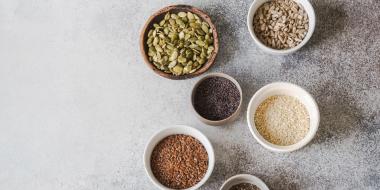For healthy development of your future baby, all the nutrients needed to grow your little one in the womb come directly from your body and the food you eat during pregnancy. This fact alone is important to consider during your preconception phase of fertility. Long chain omega-3 fatty acids are an important group of nutrients for development of both her brain and her retina, the layer in the eye sensitive to light that relays information to the brain to form visual images. For your baby to get access to long chain omega-3 fatty acids at a critical time in her development depends on your body-stores and dietary intake being bountiful.
Omegas at a glance
There are two types of essential fatty acid (EFA) families that produce a cascade of fatty acids.
Omega-3s are derived from alpha linolenic acid (ALA)—a short chain fatty acid—that ultimately transforms into the long chain fatty acids eicosapentaenoic acid (EPA) and docosahexaenoic acid (DHA).
Omega-6 fatty acids start with the short chain fatty acid, linolenic acid (LA) which produces arachadonic acid (AA).
It is the short chain fatty acids, ALA and LA, which are the true essential fatty acids. They are “essential” to our diet since the body cannot synthesize them itself. EPA and DHA can be synthesized by our body, albeit very inefficiently. And, unfortunately, our diet often comes up short which is not good thing for a developing baby. While both omega-6 and omega-3 fatty acids play an important role in how our body functions day to day, omega-3s are of especial interest for fertility.
DHA for baby’s brain
When the baby is growing in the womb he takes mama’s stores of DHA and concentrates it in his little developing brain at ten times the rate he can make it himself. This DHA is used to make neurons (or nerve cells) and phosphatidylserine, a fatty substance that protects the neurons.1 Studies have shown that low maternal intake of DHA is linked to increased risk of poor neural development in the child. Baby depends on receiving the bulk of DHA through the placenta during the third trimester of pregnancy and smaller quantities through the breast milk the first six months of life. This is an important time in a baby’s life for both brain development and visual function and post-natal supplementation doesn’t make up for a deficit while in the womb.
EFA for mama’s pain
Mama needs those EFAs too for her general health beyond pregnancy. Omega-3 fatty acids are good for heart health, reducing inflammation in diseases like rheumatoid arthritis, inflammatory bowel disease, asthma, and of course brain health. Omega-3s are used as a conjunctive therapy for depression, bipolar disorder, schizophrenia, and dementia. And depletion of mama’s DHA stores during pregnancy may be a contributing factor to postpartum depression.1
Good sources of good fats
Getting sufficient ALA and LA is not too hard if you eat a diet rich in nuts and seeds and good vegetable oils.
Oils
Plant oils such as sunflower, corn, safflower, soybean, borage, and evening primrose.
Nuts and seeds
Good seed sources include flax, pumpkin, chia, sesame and perilla; nuts that are EFA-rich are pecans, walnuts, pine nuts, and Brazil nuts.
Fish and other sources
The best way to get EPA and DHA comes from regularly eating fatty fish like wild-caught salmon, sardines, and herring; fish oils such as cod liver oil, salmon oil, and krill oil; and algae oil.
Something fishy you should know
Because the primary source of EPA and DHA comes from fish, if you follow a vegan or strict vegetarian diet, or avoid fish due to concerns regarding environmental contamination, then you are likely low in EPA and DHA.
Eating fish is a legitimate concern due to environmental contaminants, especially if you are trying to get pregnant. Some species of fish are contaminated with high levels of polychlorinated biphenyls (PCP), methylmercury, dioxins, and other persistent chemicals that have adverse effects on our health. Collectively these toxins are known to cause a range of issues from cancer to fetal defects to infertility.
The United States Environmental Protection Agency (EPA) recommends two to three servings of fish per week including salmon, catfish, cod, and tilapia, and avoiding shark, swordfish, and king mackerel.
Accordingly, as far as fish oil supplementation goes there is a potential for contamination. I recommend professional-grade fish oils that have been processed in facilities that are NSF GMP (National Sanitation Foundation’s Good Manufacturing Practices) certified. This ensures a set of “processes, procedures, and documentations to ensure that the product has the identity, strength, composition, quality and purity that appears on the label.”
Assessing omega-3 levels
Unfortunately, there is no standardized blood level of EPA and DHA established for adequate general health. Again, since omega-3 fatty acids have been copiously studied for cardiovascular health, the testing that does exist, along with reference ranges, are used primarily as a predictor of cardiovascular disease risk. The omega-3 index looks at EPA and DHA in the red blood cell relative to other fatty acids. The lower the index, the higher risk of heart disease.
In my practice I find the majority of my patients have significantly suboptimal levels of EPA and DHA. I determine this by extrapolating the cardiovascular guidelines to assess general omega-3 index status, particularly in my fertility patients. Omega-3 testing is not widely available so more often than not I just recommend a quality fish oil supplement without testing.
There is also no established daily recommended intake (RDI) for EPA and DHA. Based on studies, it is suggested pregnant women get at least 200 mg of daily DHA plus 250 mg of a combination of EPA and DHA. Since many women have food (and supplement) aversions during pregnancy it is a good idea to get your body pumped full of long chain omega-3s during preconception. The Linus Pauling Institute recommends that healthy adults eat fish twice weekly and consume a diet rich in walnuts, flax seeds, and flaxseed or canola oil, and consider daily supplementation with 2 grams of EPA plus DHA in a high quality fish oil.
Omega-3 fatty acids. Good for you. Good for your future mini. It is never too early to get your nutrients up to par when you’re planning a get-together with your yet-to-be baby. So go and gulp some fish oil and let’s make a toast to brain power and all the good health you can achieve!
To further boost your preconception optimization, be sure to check out Part 1: Coenzyme Q10 for Fertility and Part 2: Vitamin D for Fertility.
References
1. Fallon Morell, S and Cowan, T. (2015). The Nourishing Traditions Book of Baby and Child Care. Washington DC: New Trends Publishing, Inc.






